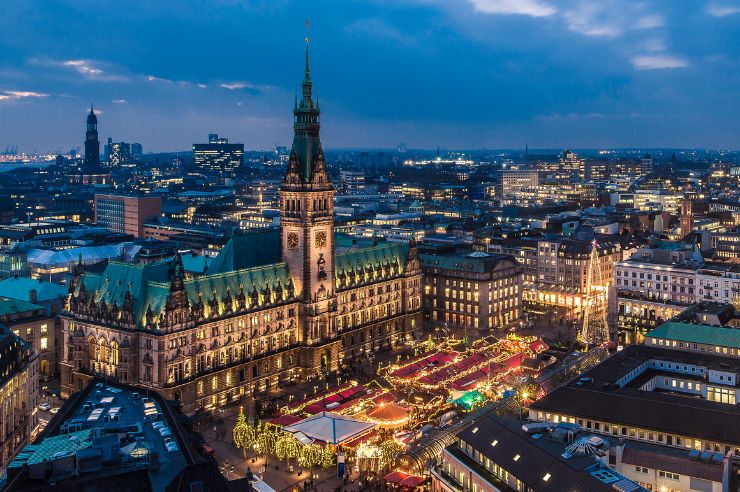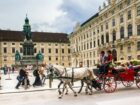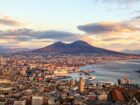Which of Frankfurt or Hamburg makes a better choice for a few days’ stay?
Hamburg has an amazing maritime heritage, beautiful old architecture, lively nightlife, and cultural sights such as the Elbphilharmonie concert hall. Frankfurt has an impressive skyline and financial district, an elegant riverfront and districts, very good museums and galleries, and great shopping.
Hamburg is Germany’s second-largest city with a population of nearly 2 million, while Frankfurt is under 800,000. Hamburg is located in the North of the country less than 2 hours from Denmark, on the Elbe River close to where it merges into the North Sea. Frankfurt sits pretty much in the middle of Germany with easy access to everything.
Both feel like real cities, though they rarely feel crowded. Both cities are well connected, Frankfurt with the biggest airport in Germany, and Hamburg with the biggest port. Both are wealthy cities with high costs of living, even by German standards.
Hamburg is a city-state founded by Charlemagne in the 9th century. It was an important member of the Hanseatic League, a powerful trading alliance of cities in northern Europe. Its location on the Elbe River and its access to the North Sea made it a crucial center for international trade. During World War II, Hamburg was heavily bombed but then rebuilt itself. It’s a thriving metropolis with an impressive port and a diverse cultural scene.
Frankfurt’s history dates back to Roman times. The city was an important center of trade and commerce during the Middle Ages, and in the 16th century was one of the most influential cities in the Holy Roman Empire. It’s a cosmopolitan city and is a thriving financial hub with a world-renowned skyline. It’s also home to both the German and European Central Banks.
Table of Contents
What travelers say
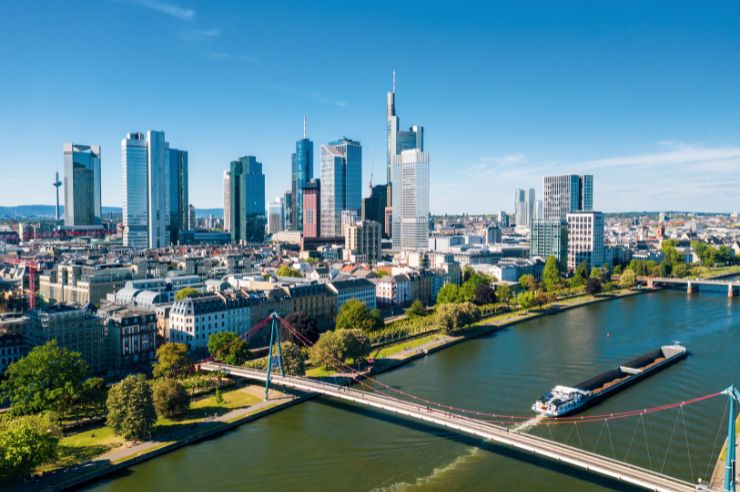
- Frankfurt is a modern international city with skyscrapers, world-class shopping, and fantastic restaurants, but at higher prices even by German standards. It’s very commercial, a major financial hub with many large banks and financial services.
- Frankfurt is the fourth most visited city in Germany following Berlin, Hamburg, and Munich. For its size has an ample supply of cultural sights.
- Frankfurt has a great market, fun walking tours with “Frankfurt on Foot”, interesting museums, and quaint Apfelwein pubs where you can try the famous Green Sauce.
- Frankfurt is the gateway to the state of Hesse which has impressive forests, a Roman spa town, medieval cathedrals and castles (including the Frankenstein castle), art nouveau architecture, fairy tale landscapes (Brothers Grimm), and the winemaking Rhine Gorge area.
- Hamburg has its charm as a port city, with great seafood and day trips to the lakes and sea. It has more of a Scandinavian feel.
- Hamburg’s highlights include the North Sea, the harbor and the ships, the Alster Lake, the Elbe River, and traditional architecture. Hamburg is more beautiful than Frankfurt.
- The food in Hamburg is better for the money, especially if you like smoked eel. The shopping in Hamburg is the best in Germany. The nightlife is second only to Berlin.
- If you’re going to remain in the city center, Hamburg has more to offer being much bigger than Frankfurt. If you plan to move around however, Frankfurt wins with the Rhine Valley, the Taunus mountains, Heidelberg, Wiesbaden, the wine country Rheingau, etc.
Getting around
Getting from the Frankfurt airport to the city center is easy. The S-Bahn lines bring you directly into the central station in 20 minutes, every 10-15 minutes.
Frankfurt’s public transportation system is great. You can access any part of the city using the network of street cars and buses.
Frankfurt is close to the geographic center of Germany. From there, you have easy access to Munich, Berlin, Stuttgart, or Hamburg, all in about the same amount of time.
In Hamburg, moving around is easy using the Hamburg U-Bahn and S-Bahn buses, trains, and ferries that connect every corner of the city. Most areas are also easily accessible by foot or bicycle.
Hamburg also has an international airport (the 5th busiest of the country) with many airlines and destinations. The airport is only 12km away from the Hamburg city center
Vibe & people
Frankfurt
Frankfurt is a business city, often referred to as “Mainhatten” for its impressive skyscrapers, or “Bankfurt” for being a banking hub, home to the European Central Bank and the Frankfurt Stock Exchange.
Since many of the buildings in Frankfurt are relatively new, it is missing the historic aspects you would find in Berlin, Munich, or Cologne.
Frankfurt is often seen as a yuppie city and is sometimes perceived as a bit bland. However, it also has a relatively large student population and decent nightlife in the Saschsenhausen area. It also has a very diverse mixture of businessmen, third-generation immigrants, workers, and artists.
Frankfurt was destroyed in large part during World War II and only part of the historical portion was rebuilt. However, it still has history to offer, and is a great city for art and architecture lovers.
Frankfurt feels more lively than Hamburg but may not have the same character and beauty as Hamburg. Frankfurt does have historic sites but you don’t get this feeling of stepping back in time like in Hamburg.
Frankfurt, however, is near the Rhine Valley and its beautiful landscapes and scenery. There are many parks and mountains to explore nearby, such as the Taunus region which is great for hiking and biking.
Hamburg
Hamburg is a beautiful city with gorgeous old buildings everywhere. The city is full of little monuments and unique areas such as the Port City.
Although Hamburg is Germany’s largest harbor, it’s 60 km from the North Sea as it sits further inland on the Elbe, and a similar distance from the Baltic Sea (about an hour’s drive). The city is dominated by the port, shipyards, and shipping and trading companies.
The people in Hamburg often have a reputation for being reserved, “grumpy” and austere. Despite such stereotypes, however, visitors and expats in Hamburg often feel the people are quite welcoming, helpful, and open-minded.
Due to the city’s seafaring tradition, Hamburg’s residents see themselves as some kind of displaced Londonians. That said, getting by in Hamburg without speaking German is typically harder than in Frankfurt where the locals are better accustomed to dealing with foreigners.
Hamburg’s lifestyle is closer to nearby Denmark – not the typical German city most international visitors expect. It’s nonetheless a beautiful (at least many parts of it) and laid-back city. Though it does not have a historic center per se, Hamburg has beautiful canals and harbor constructions.
Hamburg is a very green city with 45% of the city being park areas. While it’s a short distance from both the North Sea and the Baltic, some don’t view Hamburg as a seaside city and feel the North and Baltic seas don’t really look like real seas.
Sights & culture
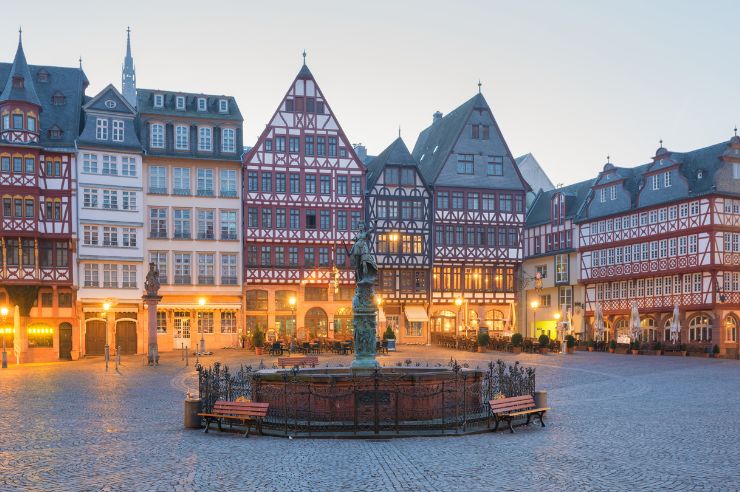
Frankfurt
If you want to spend time In Frankfurt, you won’t run out of things to do, no matter what some travelers say.
Frankfurt has an interesting old town (Altstadt), reconstructed after the war, with its central Römerberg Square. In the main square is the 15th-Century town hall hosted in three traditional patrician houses.
A short walk from the old town square is the Gothic Frankfurt Cathedral, or “Kaiserdom” (imperial cathedral), where coronations and elections of the Holy Roman Empire were held.
Another astonishing sight in Frankfurt is the bank district with its high skyscrapers, including the 56-story, 200m Main Tower.
You can also visit the 22-hectare Palmengarten, Germany’s largest and one of three botanical gardens in Frankfurt.
The Goethe Haus is a short walk from the old town square. It’s a museum where famous writer Johann Wolfgang von Goethe lived in his early years.
Frankfurt also has a landscape of great museums, second only to Berlin, lined up on and around the two banks of the Main River.
The historic Städel art museum, on the south side in the Sachsenhausen district, has a major art collection with 2,700 paintings, 100,000 drawings and prints, and 600 sculptures.
Other sights include the Museum of Modern Arts (MMK), the Film Museum, and the Alte Oper concert hall and the 19th opera house, north of the old town, which was destroyed and rebuilt in the 70s.
Eschenheimer Turm is a guard tower built in 1425 to serve as Frankfurt’s city gate. It stands 47 meters high and is one of the city’s most notable landmarks.
The Karmeliter Cloister features 16th-century frescos by Jörg Ratgeb. The enormous wall paintings depict the life of Jesus from birth to death. Entry is free.
The Kleinmarkthalle is an indoor produce market with over 150 stands offering fresh foods, produce, flowers, and other products from all over the world.
There are several Jewish memorials in Frankfurt. The Jewish Holocaust Memorial Wall has over 12,000 names, and the Medieval Jewish Cemetery is one of Germany’s largest and oldest cemeteries. You can walk to the nearby Jewish Museum to learn more about Jewish history.
Note that “Frankfurt on Foot” is a fun and well-rated walking tour and a great way to explore the city. It takes around 3-4 hours to complete and brings you to the best historical sites in Frankfurt.
Frankfurt has a great collection of museums. Some of the more popular ones are the Städel, Schirn Kunsthalle, and the Modern Art Museum.
Some other museums to consider seeing are the Senckenburg (natural history), the Communication Museum, the Ikonen, and the Liebighaus, known for their fine collections of sculptures.
Interesting neighborhoods to visit include lively Bornheim, Höchst with its historical buildings, Westend, a good place for a stroll, and Sachsenhausen, a local favorite.
Hamburg
In Hamburg, you can take a harbor cruise, go check out the Speicherstadt, the largest warehouse district in the world with buildings standing on oak logs, or have a couple of Pilsener on the Reeperbahn or along the Alster Lakes, two artificial lakes created from the damming of the Alster River.
Sights include the Rathaus (seat of the local government) and the St Nicolai Mahnmal (Lutheran gothic revival church with a panoramic view of the city).
Hamburg’s Elbphilharmonie is a stunning concert hall that is home to some of the best classical music performances in Europe.
The St. Michaelis Church is an iconic landmark of Hamburg due to its impressive Baroque architecture and stunning views of the city.
The International Maritime Museum is a fascinating museum that explores the city’s seafaring past, with model ships and interactive displays.
The Miniatur Wunderland features a vast miniature world with incredibly detailed model landscapes and cities from around the world.
You can walk along the Jungfernstieg (7km urban promenade on the Alster lake) or take a boat tour for stunning views.
You can visit the harbor area and take one of the public ferries from Landungsbrücken on the Elbe. Visit the old Tunnel under the Elbe and the new city area (HafenCity) by the river.
Much of the city can be visited on foot if you feel like walking for miles, otherwise, you can easily use public transportation for getting around.
Hamburg has great lake and river views, boat tours, and endless promenades in addition to some nice Gothic architecture buildings.
There are several big beautiful parks in Hamburg – Planten un Blomen has the biggest Japanese garden in Europe.
It offers plenty of cultural attractions, such as the Elbphilharmonie concert hall, the St. Michaelis Church, and the Miniatur Wunderland museum.
Food & nightlife
Frankfurt
Frankfurt is in the middle of Germany’s most prosperous and oldest wine regions. The Riesling and Reingau wines are particularly remarkable.
Some typical Hessian/German specialties include the “Quetschemännsche” which are small figures made of nuts, raisins, and prunes. Another thing to try is the Feuerzangenbowle German punch.
Travelers recommend walking from Downtown across the river to the Sachsenhausen area, and entering one of the many apple wine taverns, some of which are over 100 years old and offer great food.
Frankfurt has distinctive traditional food such as Green Sauce, Handkäse (strong marinated cheese and onions on bread), and Applewine (fermented bitter apple juice). You can find many places serving these specialties in the Sachsenhausen district.
After dinner, you can wander through the quaint Old Sachsenhausen nearby. It’s an old town with beautiful buildings and streets, a great place to stop for a bite to have a glass of wine in the old-style bars, pubs, and discos, contrasting with the trendy modern bars found north of the river.
Kiosks offer wegbier ((beer for walking). You can grab a couple in a bag and take a stroll along the river, or just sit and relax at the Alte Oper or Willy Brandt Platz.
Frankfurt is not as hip, vibrant, and alternative as Berlin, but it also has its great, underrated charm. Many popular pubs and clubs where the international community likes to hang out (e.g. JazzKeller, Zoom Frankfurt, Roomers Bar) are located North of the Main River in and around the old town.
The 300-seat English Theater in the Gallileo Skyscraper offers nice performances to a very international public and is an important piece of Frankfurt’s cultural life.
Brunch on weekends is a big thing in Frankfurt, you can have a nice and affordable meal including crepes and waffles in a café or bar of the Hauptwache, Marienplatz, or Bornheim Mitte district.
In the evening, you can also have a beer at the Hauptwache café and watch Mainhattan business people go by.
Hamburg
In Hamburg, seafood is very abundant due to the proximity of the sea. You can enjoy crab rolls (Krabbenbrötchen) or Matjes herrings in restaurants outside the harbor.
Hamburg has a lively nightlife – though some might say a bit more sleazy than Frankfurt, which is often the case in port cities. The most famous street for going out is the Reeperbahn, including near the Paul-Roosen Straße in the North section.
Hamburg has a wide range of pubs and bars including beer gardens, breweries, beach clubs, cocktail bars, traditional bars, wine bars, etc. There are good bars in the Stenschanze area around Schulterblatt and Schanzenstraße. The St.Pauli district is known for its good nightlife.
Both Frankfurt and Hamburg are well-off and generally safe, they both have well-known red-light districts – Hamburg’s Reeperbahn close to the harbor, and Frankfurt Bahnhofsviertel (railway district). In both cities, the red-light district is becoming a hip area for trendy crowds and clubbers.
Shopping
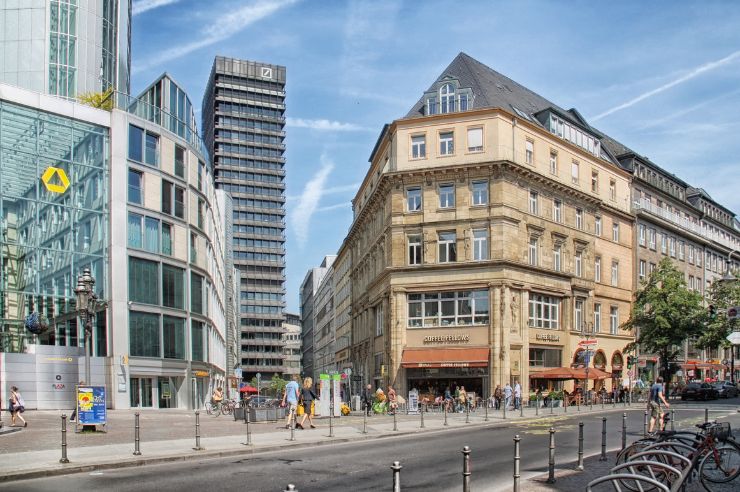
Frankfurt
The Zeil is Frankfurt’s foremost shopping destination, renowned as one of the most recognized shopping streets in Germany.
Much of its remarkable architecture was bombed flat during the war. The street now has imposing department stores with impressive designs, such as the My Zeil and Galleria Kaufhof arcades.
The pedestrian zone, a long open promenade in the city center, spans between the Hauptwache and Konstablerwache plazas, with hundreds of shops.
Berger Strasse offers a nice mix of shops, small restaurants, and bars. It’s a great place to take a break from shopping and have some traditional-style food or simply have a coffee.
Hamburg is known for its great shopping, including:
- Neuer Wall Street – major international fashion brands
- Colonnaden pedestrian area
- Jungfernstieg waterfront and promenade shopping area
- Spitalerstrasse shopping district – one of the most visited in the country
- Mönckebergstrasse Street – elegant shopping area
- Europa Passage city center shopping mall.
Lodging
Frankfurt
Frankfurt is quite expensive but you can find a wide variety of places to stay. You can choose to stay in the Zentrum-Altstadt “old” city center so as to be within walking distance of the main square, rebuilt medieval buildings, and landmarks.
A more affordable option is to stay in the Bahnhofsviertel district West of the city center, a revamped and lively area next to the main train station (and Frankfurt’s red light district).
Sachsenhausen, across the Main River from the old center, is a good neighborhood to stay in for nightlife. It’s a creative and bohemian neighborhood with narrow streets and numerous restaurants, bars, and clubs.
Another option is the Gutleutviertel riverfront district, one of the most recently revamped neighborhoods in Frankfurt.
Bornheim is a nice and quiet alternative East of the city center, with cobblestone, tree-lined streets, and alley paths. It’s close to the Zoo and botanical gardens and has a nice historic feel as well as trendy shops.
A few recommended hotels:
Steigenberger Icon Frankfurter Hof is located near the historic district of Frankfurt. It is an elegant hotel, with both modern and traditional decorations. It has a spa and Turkish bath, great outdoor seating for breakfast, and classy indoor rooms for dining.
If you want to be right in the middle of Old Town Frankfurt, the Hilton Frankfurt City Centre is in a great location. It has a spa, gym, and half-size Olympic swimming pool.
The Frankfurt Marriot Hotel offers rooms with fantastic skyline views of the city and is only one kilometer from the central station. It has easy access to the A4 motorway and underground parking.
The renowned Sofitel Frankfurt Opera is a 5-star hotel in the Old Town. It has a modern upscale feel. You can dine indoors or outside to with scenic views of the city.
Hamburg
In Hamburg, most people choose to stay close to the city. Good areas to stay in include Altstadt, Neustadt, Saint Georg (except the areas East of the central station), HafenCity, and St Pauli which is close to the Reeperbahn bars and restaurants. Avoid staying South of the Elbe, though.
Travelers recommend the Sofitel am Alten Wall as it was right in the city center and close to everything.
Day trips
Frankfurt
Heidelberg is about an hour away by train, where you can visit Heidelberg Castle, one of the most impressive castles in Germany. The old town and marketplace are very lovely, along with the historic university.
The Baroque architecture of Würzburg is worth the train ride from Frankfurt. It’s right on the Main River. Enjoy the wine, and explore the wonders of the massive Würzburg Residence. The tour of the interior is breathtaking.
In Rüdeshiem take a pleasant boat ride on the Rhine River. This small quaint village is known for its wine, old traditional houses, and small cobblestone streets. A great way to relax in a friendly atmosphere.
You can go to Mainz or Wiesbaden, and also visit the scenic Rhine gorge with its castles, vineyards, and small towns.
Hamburg
From Hamburg, the charming town of Lüneburg is only a short train ride away – it has a picturesque old town with cobbled streets and a historic market square. The town of Lübeck is another similar option.
Also close by is the seaside town of Timmendorfer Strand has beautiful beaches, quaint shops and cafes, and water sports activities.
You can also take a day trip to Denmark, the border being only 1h30 away by car or train.

